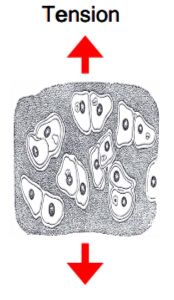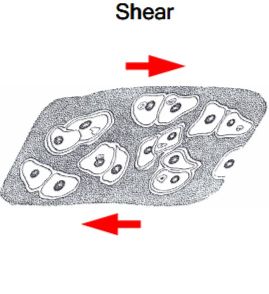Biomechanics of the Insertion
Introduction
Mechanics is defined as a branch of science which deals with the motion of objects and the forces acting on objects.
Biomechanics is the study of the structure and function of biological systems by means of the methods derived from Mechanics. The human skeleton including the tendon and ligament insertions are subject to the laws of Mechanics.
Engineers recognise that the application of large forces to a small surface area may pose major structural challenges. Engineers also recognise that the bonding of two completely different materials also poses special challenges.
Enthesis Biomechanics
The enthesis represents a complex biomechanical challenge in that large muscle forces are often concentrated on a small insertion point and that soft tissues (ligaments and tendons) are bonded to bone (a hard tissue).
At the actual insertion point of most entheses a shock absorbing elasticated tissue that has no blood vessels of nerves. This tissue is termed fibrocartilage.
Fibrocartilage has properties similar to that of articular cartilage which is the spongy compressible shock absorbing material that covers the end of bones. The difference between articular cartilage and fibrocartilage is directly related to the mechanical forces applied across the joints.
The cartilage on the ends of bone is subject mostly to compression.
 |
| The cartilage at the end of long bones is subject mostly to compression. The forces acting at the end of the bones are also directly transmitted into the bone. |
Fibrocartilage is a type of cartilage that develops at sites of compression, tension and shear forces. It presence indicates that complex forces are acting on the tissues.
 |
 |
 |
| The fibrocarilage at insertions is compressed. It is also subject to tension because of the pull of the tendon at the insertion. The friction between enthesis organ related tissues also leads to a force called shear. | ||
Enthesis and Bone Biomechanics
The functional integration with fibrocartilage with the immediately adjacent bone means that the forces acting at the enthesis also act on the adjacent bone. This is crucial for understanding the link between diseases of the enthesis and how they also affect the bone.
Bioengineers have discovered that bone functions best when it is undergoing only one mode of loading such as compression or tension. For example, compression alone is well tolerated. Tension alone is well tolerated.
However, the combination of compression and tension is associated with a much greater likelihood of damage [1, 2]. The region of the enthesis is a site that appears to be linked to an increased risk of such microdamage
In Mechanics it is well known that engines and other moving parts are subject to fatigue and eventual failure with even the most reliable car engines eventually wearing out. A very complex tissue repair response that includes micro-inflammation counteracts the consequences of enthesis biomechanics.
Other Considerations
Age related changes in the properties of the enthesis could affect the responses to forces and have an important bearing on disease expression. Joint injury and patient weight are likely to be important factors in diseases of the enthesis as both these factors can change its mechanical proproties.
If a region of an enthesis is subject to predominant compressive forces then articular type cartilage, rather than fibrocartilage may be evident.
If an enthesis is subject to predominant tension such as the deltoid insertion, without compression there may be an absence of cartilage.
The presence of fibrocartilage indicates that the patterns of skeletal loading are complex.
